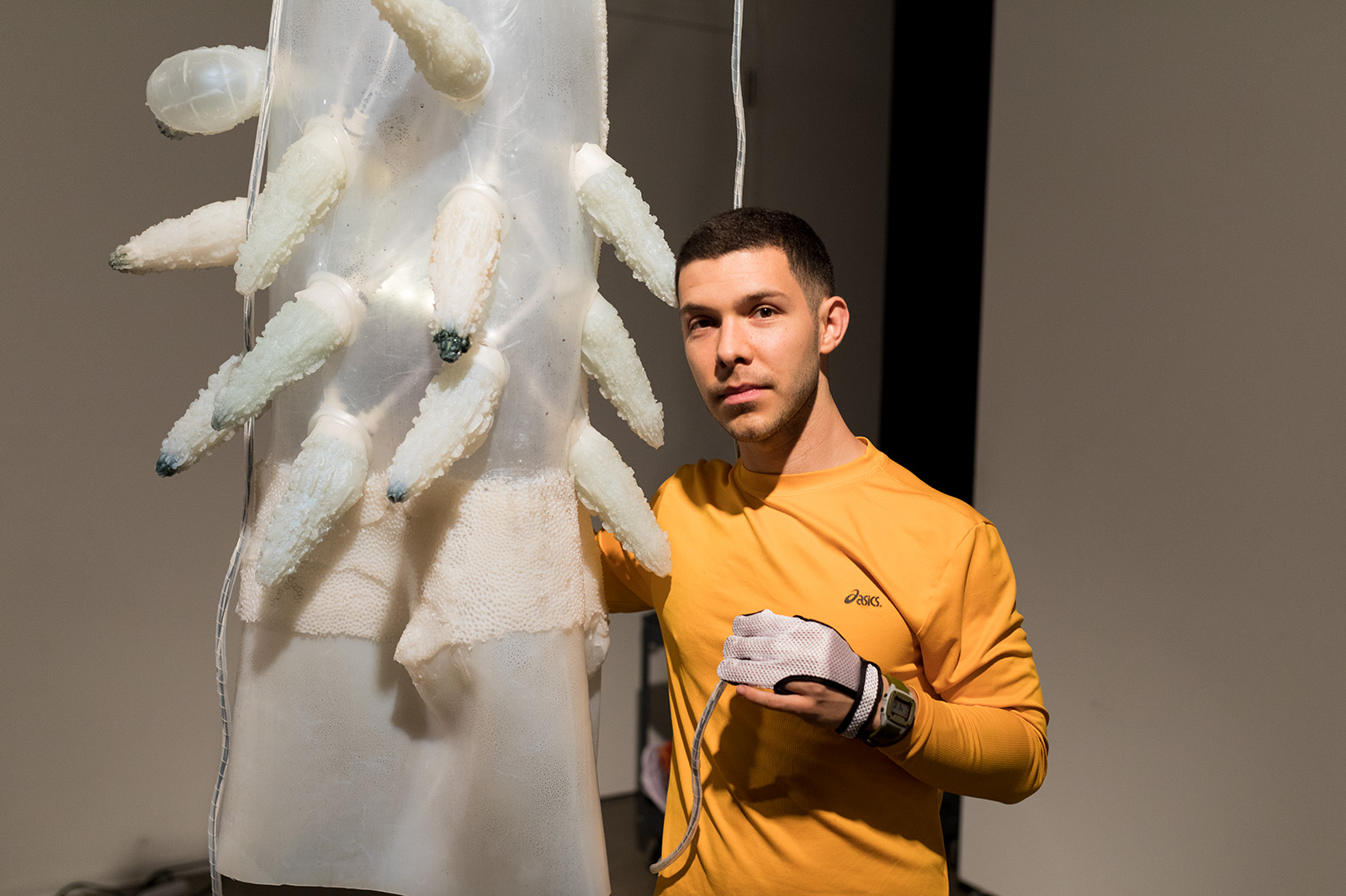MFA student presents exhibit with human interface, life-like technology

Graduate student Paul Carlo Esposito is displaying his exhibition, “Life Alert,” at the Broad Art Center. The exhibition features a variety of art forms such as video and kinetic sculptures and will represent the relationship between living organisms and technology. (Chelsea Zhang/Daily Bruin)
By Polina Cherezova
Feb. 27, 2018 11:19 p.m.
A Life Alert commercial inspired the name of Paul Carlo Esposito’s latest exhibition.
Esposito said his exhibition alerts audience members of their connection to all living things. The design media arts graduate student will feature some of his most recent artworks, including sculptures and videos, in his “Life Alert” exhibition, which opened Tuesday and will run until Thursday in the Broad Art Center. Esposito aims to explore biological and ecological functions and their relationship to art and technology.
“I’m really interested in what we think of as alive,” Esposito said. “This idea of … the boundaries between what we consider human and nonhuman.”
“Life Alert” spans across two rooms: The front room features art videos, coral fossil concrete art, kinetic sculptures and a soft robotics fish tank, and the back room houses the exhibition’s centerpiece – a large silicone robot called “Symbiogen.”
The inspiration for “Symbiogen” came from the concept of symbiogenesis, the evolutionary theory of organisms benefiting from one another by feeding and living off each other. Esposito created the 4-foot-tall soft robot to resemble a pyrosome, a giant 60-foot-long bioluminescent jelly sea-creature colony made up of hundreds to thousands of free-floating organisms called zooids.
Esposito uses soft polymers like silicone to create robots, which appear often in his work. Silicone materials are suitable for creating life-like technology because they are comprised of polymer, oil and sand, he said. The combination of sand, the most abundant mineral on the planet, and oil, the most precious mineral on the planet, creates a texture that imitates human skin.
In “Symbiogen,” Esposito created 18 smaller robots that he placed onto a silicone tube and used 3-D printed molds to shape the silicone layer into the form of a smaller pyrosome. Fascinated by strange textures, Esposito added tentacles with a bumpy surface similar to that of Indian bitter melons to the work. He also coated “Symbiogen” with a brown translucent slime resembling crude oil to represent the idea of a naturally occurring substance destroying the planet. Esposito said the slime looks like the slime made from Elmer’s glue and borax, which many children make in elementary school.
Esposito is interested in the kinetic sensations of art and said he hopes the audience will interact with “Symbiogen” by touching its slippery surface.
“I really hope to make technology that could connect people, or make people aware of connections that they’re not aware of,” Esposito said.
To illustrate how human life communicates with artificial technology, “Symbiogen” will feature a live performance by Esposito and a guest performer. The silicone robot will appear as if it is eating Esposito halfway, symbolizing indigestion and the partial breakdown of the human body, he said. The guest performer will be acting as a caretaker who maintains the slime on the robot and mists it to keep the slime from drying out.
Rebeca Méndez, a design media arts professor and Esposito’s faculty advisor, said the performance is an uncanny juxtaposition of the biological human body and the plastic organism. Instead of using artificial intelligence to control the robot, Esposito will control the robot himself, in order to further explore the idea of human interaction with technology.
“There is a kind of morphing of these two completely differentiated substances,” Méndez said. “Dissolving our self and the body within an organism that is very plastic-like but at the same time still very alive, engulfing our understanding of what humanity is.”
Samuel Congdon, one of the guest performers and a graduate student in design media arts, said Esposito’s work is both alive and artificial, which is especially relevant now that humans are creating artificial life. Although “Symbiogen” is robotic, its fluid motions invite people to explore the humanity inside of it, he said.
“All of his pieces, they sort of take on the character of living things in the way that they move or the way that they breathe,” Congdon said.
“Symbiogen” is just one of the many pieces in Esposito’s exhibit that brings technology to life. Esposito said his “Life Alert” exhibit will utilize technology to bridge the concepts of life with the concept of crises in relation to ecology and climate change.
“I want people to think about how technology makes it weird to see where our bodies end or … what kind of connections can be made to other humans, nonhumans (and) life forms through technology,” Esposito said.


